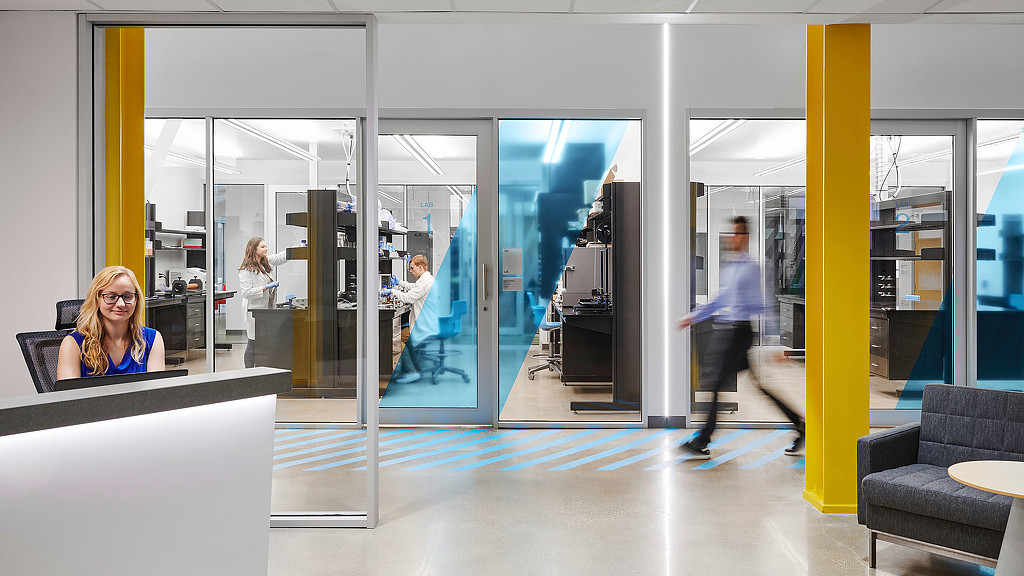Five Considerations for the New Lab of the Future
August 10, 2021 | By Paul Wilhelms
The pandemic has forced us to instantly change our frame of reference to a new way of working and living. As workers and companies reevaluate their roles and use patterns of their office space, the office could take on a new role as collaboration hub or touchdown space. While demands for future office space may differ, people whose jobs are reliant on in-person collaboration and specific spaces in the workplace are significantly more likely to want to return to the office, according to Gensler’s 2020 U.S. Workplace Survey. That’s especially true for research and production laboratories, the very places where cures for pandemics are created and produced. We have an opportunity to create a new kind of lab environment — one where ideation and innovation takes center stage.
Unlike most office-based jobs, it is not possible to conduct many research functions at home, and researchers need custom spaces and equipment to do their work safely. Additionally, researchers oversee work that has been in progress for years and cannot be put on hold, especially when it relates to animal research or requires specialized scientific equipment. While COVID-19 will change how people work in labs, it will not reduce the need for lab space and specialized support functions.
During the pandemic, work has continued in laboratories (although on a restricted basis), since scientists are already trained to work in hazardous environments and labs are already outfitted with specialized ventilation systems to protect worker safety. That said, many researchers do much of their writing and other administrative tasks at home. So, what will the next iteration of the lab look like?
The pandemic has given us new insights into the “lab of the future,” and it includes more integration of the office with the lab. Aside from the typical COVID-19 directives to wear masks and practice social distancing, several other aspects must be considered when designing new labs:
1. Increased compartmentalization is key.For researchers, both their lab spaces and offices must have segmentation to help limit the spread and impact of an infection. A lab typically has some compartmentalization — physically blocking or compartmentalizing different spaces within the lab environment — to manage chemicals and fire codes, but there is room for improvement. For example, each compartment could be a highly flexible zone that can be modified to fit specialized research without disrupting the other spaces in the lab. These adaptable spaces can also better control accidents and contamination and can help in limiting cleaning after an infection. For the office area of the lab, some compartmentalization can support better focus and team identity and provide a team the ability to be a “COVID-19 pod.” Collaboration areas are still necessary, but they can be designed to be separated from other zones. In the event of another pandemic, they can also be closed until cleaning after an infection is completed.
2. Introduce outdoor meeting space for each tenant.Traditionally, adding operable windows and outdoor balconies to labs hasn’t been considered possible since air flow direction and pressure tiers would be disrupted. But by using a conference rooms or other spaces as a vestibule, it is possible to allow labs to have access to fresh air for meeting spaces and provide space to hold meetings outdoors. Fresh air and views help make meetings more enjoyable and encourage more creative collaboration and discussion, while also potentially mitigating airborne pathogens.
3. Install better ventilation for critical facilities.Nearly every developer and organization is interested in better ventilation for indoor spaces, but for labs, it’s a critical concern. While labs have ventilation systems that provide outside air using HEPA filters and UV-C sterilizers, the office spaces that support lab operations do not typically have this same level of air quality. Since these offices are critical facilities that support operations in a pandemic, they must have stronger ventilation via HEPA filtration and bipolar ionization with ducted returns from multiple locations to limit virus transfer, as well as offer more access to outside air.
4. Automate workflow and tasks for greater agility.Automated or remote-controlled scientific equipment can further enable the segmentation of workflow, organize people into “pods,” and generally keep projects running with fewer staff on site. A core staff of technicians can manage the equipment and run samples in the lab, sending results to investigators working from home.
Similarly, the trend of using contract services for repetitive lab and vivarium processes has grown in the past decade. Today, there are a robust number of services companies that allow the investigator to set parameters and the company provides the output from a distance. Not only do these approaches reduce exposure for the research group, but they also provide greater agility and support for changes in research direction.
5. Considerations for office to lab conversions.The pandemic is fueling the conversion of empty offices to labs, especially in urban markets where life sciences are thriving. However, there are several unique considerations for these conversions. First, know your tenant to assess exactly what unique space requirements they’ll require. Building owners and developers should also consider solutions such as robust electrical systems; large floor plates; loading docks; and high ceilings that can accommodate the extensive ductwork necessary for ventilation, water lines, and other HVAC systems. Finally, flexible space is key to accommodate rapidly-shifting research priorities.
We see this new lab paradigm as an opportunity to provide a better, safer laboratory, one that enhances creativity and the human experience while spurring innovation and creating solutions to our world’s greatest challenges.
For media inquiries, email .

